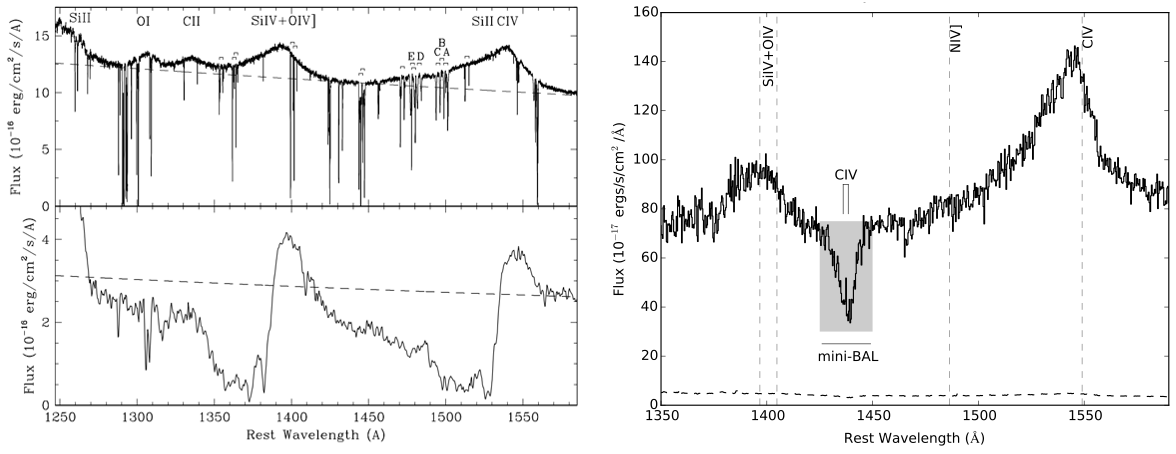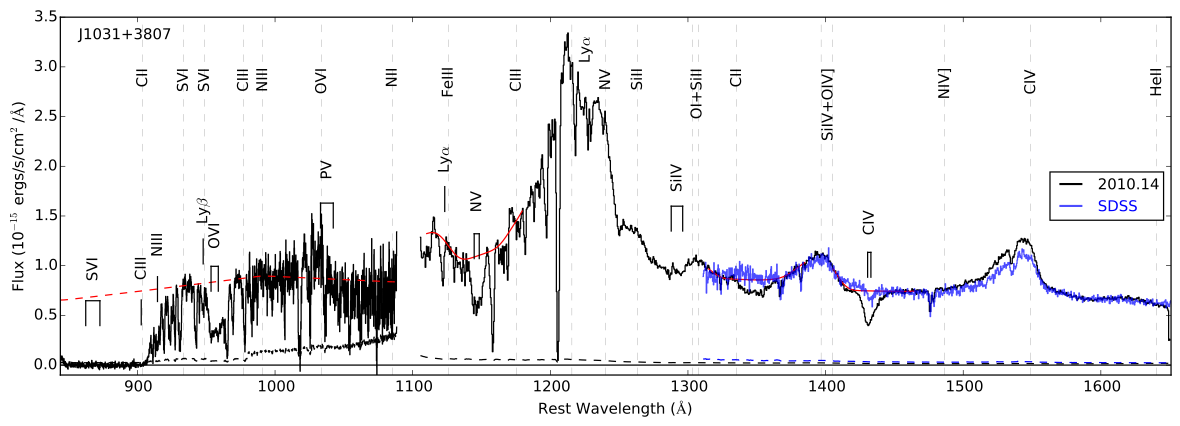Research Questions
- What are the locations, energetics, and physical properties of quasar outflows?
- What are the relationships between the different types of outflows (Broad Absorption Lines, Mini-Broad Absorption Lines, and Narrow Absorption lines)?
- Are the mass loss rates and kinetic energies in quasars sufficient for AGN feedback to occur?
Quick Summary
Through geometrical arguments and substantial variability in the spectra, we find that the moving structures of outflows are clouds which are ~ 1 pc from the black hole for both mini-BALs and BALs. We also find that mini-BALs seem to be more variable than BALs. And lastly, using lower limit on total column density for the BAL quasar in the sample, we find that the kinetic energy is at least marginally sufficient for AGN feedback to occur.
Publication:
Video Summary
- An 8 minute video summarizing this work with the public being the intended audience: Cosmic Scrapbook
A More in Depth Summary
Background and Motivation
The observational manifestation of quasar outflows is blue-shifted absorption lines in quasar spectra. There is a wide range of outflow types which are categorized according to their absorption line widths:
- the lines with the smallest width are called Narrow Absorption Line (NALs) and have a width of less than a few hundred km/s (shown in the top of the left panel of the figure below – Hamman+12)
- the most prominent and broadest lines are called Broad Absorption Lines (or BALs) and have widths of greater than or equal to 2000 km/s (shown in the bottom of the left panel of the figure below).
There has been a large effort to understand these two outflow types and thus this study focuses on a class outflow lines with intermediate widths called mini-BALs (shown in the right panel of the figure below – Moravec+17). Of the three classes of absorption lines, mini-BALs, are the least well-understood (as only a few studies with large samples or broad wavelength coverage have been carried out).

Sample and Data
As mini-BALs are the class of absorption lines that are the least well understood, they are the main component of our sample. We created a sample of a variety of outflow strengths ranging from weak mini-BALs to a strong BAL in CIV in order to probe the ranges of physical characteristics of mini-BALs and compare them to BALs. In total we have 6 mini-BALs and one BAL (z~1.6-1.8).
Each quasar has anywhere from 3 to 6 epochs of data taken across a range of approximately 10 years in observers frame and we use this to determine the variability in CIV which can be combined with other measured properties of the outflow lines to characterize the physical structure of the flows. Each quasar was observed once with HST nearly simultaneously with a ground observation - these two observations together give a wide wavelength coverage in the UV that contains important diagnostic lines.

Conclusions and Answers to Research Questions
Q: What are the locations of the quasar outflows?
A: We find that the variability of the spectra combined with evidence of saturation of the absorption lines implies that the covering fraction must be varying which indicates that cause of variability is clouds crossing along line of sight. We can thus calculate the transverse velocity of the cloud and derive the distance of the absorber from the BH to be ~1 pc for the mini-BALs and BAL (mini-BALs 0.4 pc - 8 pc).
Q: What is the physical structure of quasar outflows?
A: We find that the structure of the outflows is clouds each with a dense core that is less ionized surrounded by a more diffuse cloud that is more highly ionized.
Q: Are the mass loss rates and kinetic energies in quasars sufficient for AGN feedback to occur?
A: We find that the kinetic energy in the BAL quasar is at least marginally sufficient for the quasar outflow to affect its host galaxy by shredding and dispersing ISM clouds, suppressing star formation.
